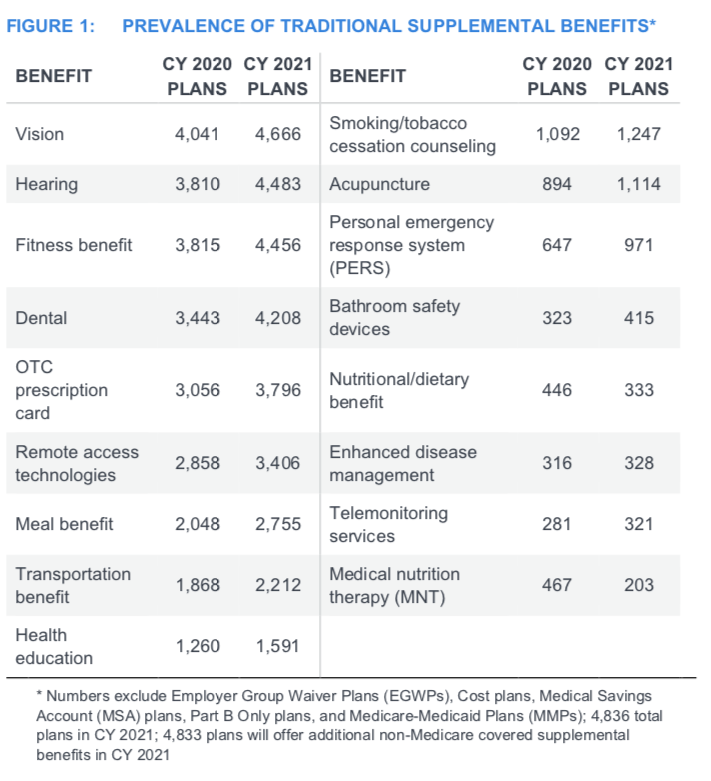Analysis: Medicare Advantage Supplemental Benefits Grew in 36 out of 41 Categories for 2021
57% of Medicare Advantage plans now offer meal benefits, while 46% provide transportation to appointments. Diabetes is the most targeted disease for uniformity flexibility by a wide margin.

Washington, D.C. (February 11, 2021) – Better Medicare Alliance, the leading research and advocacy organization supporting Medicare Advantage, released a new data brief prepared by the actuarial consulting firm Milliman that examines offerings of both traditional supplemental benefits and Special Supplemental Benefits for the Chronically Ill (SSBCI) in Medicare Advantage from 2020 to 2021.
Over the last year, the number of health plans offering supplemental benefits grew in 36 out of 41 categories measured, including 15 out of 17 traditional supplemental benefit categories, 4 out of 5 expanded supplemental benefit categories, and 17 out of 19 SSBCI categories. Benefits that are most widely offered in Medicare Advantage include vision (provided by 96% of plans), hearing (93%), fitness (92%), and dental care (87%).
This year, 57% of Medicare Advantage plans now provide a meal benefit while 46% of plans offer transportation to and from physician appointments. Nearly a quarter of Medicare Advantage plans provide acupuncture as a covered supplemental benefit.
Among SSBCI, food and produce and meals (beyond a limited basis) were the most widely provided benefits, reaching more than 1.9 million and 1.5 million total beneficiaries, respectively.
The Milliman analysis also examines the clinical conditions for which Medicare Advantage plans most frequently offer supplemental benefits allowed under SSBCI, which requires the supplemental benefit to be targeted to chronically ill beneficiaries. Beneficiaries with diabetes were the most targeted population for these extra benefits by a wide margin. For 2021, 293 Medicare Advantage plans offer reduced cost-sharing and/or additional benefits to support diabetic beneficiaries in managing their chronic condition in plans with nearly 1.5 million total covered beneficiaries.
Notably for 2021, use of SSBCI for behavioral health diagnoses (e.g., anxiety, depression, or substance use disorder) also grew significantly, with 135 Medicare Advantage plans providing reduced cost-sharing and/or additional benefits in 2021, as compared to five plans the year prior. Congestive heart failure and Chronic Obstructive Pulmonary Disease (COPD) also ranked near the top of the most targeted disease groups.
“This analysis provides unique insight into the ways that Medicare Advantage continues to innovate and enhance benefit offerings, even in the face of the extraordinary circumstances presented by the COVID-19 pandemic,” said Allyson Y. Schwartz, President and CEO of the Better Medicare Alliance. “In 2021, benefits like vision, hearing, fitness, and dental care that remain unavailable in Traditional Medicare became nearly universal in Medicare Advantage. In addition, over three-fourths of Medicare Advantage plans provide discount cards to help keep beneficiaries’ out-of-pocket costs on medications low, and 57 percent of plans are providing meal benefits that can be particularly meaningful to seniors during the current pandemic. The growth of extra benefits and lower out-of-pocket available to seniors, including those particularly targeted to individuals with chronic conditions, demonstrates the value that Medicare Advantage continues to deliver for millions of beneficiaries.”
Schwartz continued, “More than 500 Medicare Advantage plans provide reduced cost-sharing, expanded benefits, or some combination of the two in order to help meet the needs of over 2.2 million beneficiaries. Diabetics, those facing behavioral health challenges, and beneficiaries with congestive heart failure and COPD are among those most helped by this important flexibility.”
Read the full brief from Milliman HERE.
###
